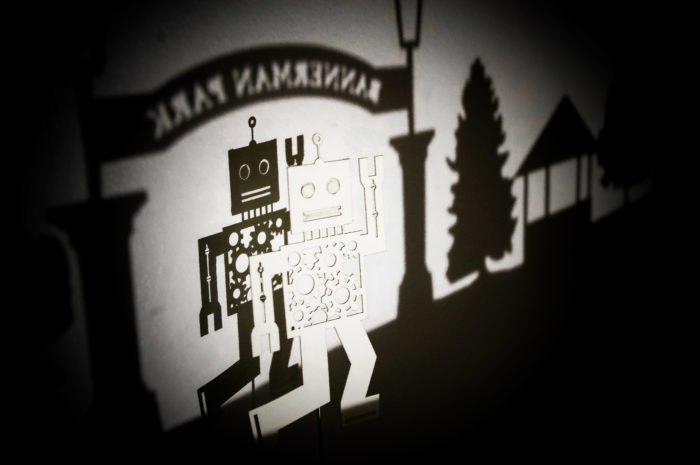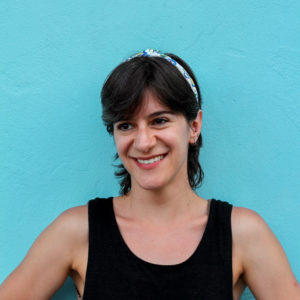New Art Writing by Nicole Haldoupis, on the work of Monica Ila
Essay available in LARGE FONT
Q&A with Monica Ila
by Nicole Haldoupis

Upon visiting Monica Ila’s I Dream In Shapes and Shadows, signs invite you to “pick up the lightbulb to shift the shadows.” “Play with the shadow puppets,” they said, so I did.
Touching the work—especially while alone in the dark gallery—felt like a forbidden treat. My hands sifted through paper whales, mermaids, and aliens before settling on a waving ghost (who were they waving at?). The ghost puppet and I found our way to the light and danced through the St. John’s skyline projected onto the wall by Ila’s paper cut-out.
*
How long did I Dream In Shapes and Shadows take you to create? Did certain pieces take longer than others? Why? (Tell me a bit about your process for this project!)
I started working on this exhibition at the end of last year. I took a walk with my sweetheart to Fort Amherst to get some pictures that I later used as reference when drawing out portions of St. John’s. One of the most challenging parts of this exhibition was trying to capture recognizable sections of the city in shadow.
The titular piece I Dream In Shapes and Shadows was the most time consuming.
Making a rotating 24-inch paper sculpture is actually like creating a long continuous 75” paper cut. If you’re trying to combine several streets, you only really have about 15 inches to give an impression of a particular area. It almost broke my cartographer brain in moments but I’m very pleased with its final results.
Why did you want this exhibition to be interactive?
As an introverted human, the idea of sneaking away appeals to me greatly. It is the pull at every party I’ve ever been invited to without a dance party, household pet to befriend, or craft table. This exhibition is a fancy shadow closet for people to sneak away and play in.
Why did you decide to use these forms (paper sculptures and shadow puppetry) for this project? How do these forms contribute to the work?
Paper is an exciting medium that I started using a few years ago because of the ability to play with shadows, layers, clean lines, and depth. It also has a relatively low environmental impact from a materials standpoint. I try to reuse existing materials in my sculptural practice and am always cognizant of the waste created as part of the making process. Artists (myself included) often learn by creating iteratively throughout their careers. We create a huge inventory of work—a wonderful and challenging thing to live with (because it most likely lives with us in our homes). Part of our responsibility as makers is understanding what we do with our work after we make it, what we do with the trials/excess materials and how it weathers after we’re no longer around.
How does landscape and the place you’re living in impact your work?
This exhibition ended up being a small love letter to St. John’s. It’s a very special place. I wanted to create a piece where the city was also a character. In creating the main shadow piece—it opened up so many other aspects to explore.
Is there a particular artist or artists that have influenced you and your work?
Many artists inspire me ranging from famous, mainstream artists such as Alexander Calder to interactive art with a sense of humour such as Bangalore-based artist duo Pors & Rao. I am excited by the puppet shows of the Old Trout Puppet Workshop, the whimsy of giant maker Thomas Dambo, the enchanting scenes of paper cutting duo Hari & Deepti or street artist Joe Irato who plays with scale and environments. There are also collectives like the Guerrilla Girls that help to change the conversations of art and have continued to do so for decades. My pseudo mother-in-law Marie-France Nitski is a wonderfully wild artist. She’s a painter who has had a long career of creating the art she wants to make in a close-knit community.
What is your earliest memory of making art?
Some of my earliest memories include me turning closets into space elevators with cardboard dials, writing plays with my friends as characters and drawing their costumes, making tiny villages out of empty Nerds candy boxes and milk cartons. I used to cut out the Nerds characters and turn them into puppets.
You could say my childhood self knew what I was happiest doing before my adult self caught on.
*
Visitors are encouraged to leave Monica a note about their visit in the notebook provided at the gallery!

Photo Credit: Danielle Haldoupis
Nicole Haldoupis is a queer writer and visual artist from Toronto. Her first book, Tiny Ruins (Radiant Press, 2020), was shortlisted for four 2021 Saskatchewan Book Awards and the 2022 Bressani Literary Prize. It is currently being adapted into a feature-length film by Rogue Rock Pictures. She’s the managing editor at Breakwater Books, a former editor of Grain and untethered, and an innkeeper at the Rendell Shea Manor. She lives with her partner and cat in St. John’s, Newfoundland and Labrador.